IDW goes “Heavy Metal” with “Doomed” Mag
By Mark Wheaton
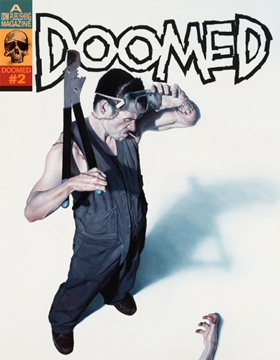 Horror anthologies are always around – whether they’re books, movies, TV shows, whatever – as some of the best horror stories like to color outside the lines of a feature-length film or a novel-sized tome. That said, they’re difficult in trying to nail down a solid tone. “Tales from the Darkside: The Movie” versus “Creepshow,” “Creepshow 2” versus the original “Tales from the Crypt,” hell – “Tales of Terror” versus “Twilight Zone: The Movie.” It’s a mixed bag.
Horror anthologies are always around – whether they’re books, movies, TV shows, whatever – as some of the best horror stories like to color outside the lines of a feature-length film or a novel-sized tome. That said, they’re difficult in trying to nail down a solid tone. “Tales from the Darkside: The Movie” versus “Creepshow,” “Creepshow 2” versus the original “Tales from the Crypt,” hell – “Tales of Terror” versus “Twilight Zone: The Movie.” It’s a mixed bag.
But now, horror comics giant IDW has hit out with issue #2 of their “Heavy Metal”-esque, black-and-white horror anthology magazine “Doomed” and it’s…great.
So many horror anthologies in text form grab a few “name” authors to slap on the cover (Ramsey Campbell, Stephen King, Jack Ketchum, etc.) and then it goes downhill from there. Here, we’re treated to four adaptations from some horror greats as David J. Schow, Richard Matheson, Robert Bloch and F. Paul Wilson followed by a terrific interview with
Schow’s “Bagged” kicks it off, adapted by Chris Ryall with art by Ashley Wood and it’s a grim, vampire-hunting story that takes place in a vampires-are-people-too type future, but done dead-serious. Until the last moment, that is. Not only is this the perfect-sized story to do in an anthology, its wacky “Twilight Zone” quality mixed with excellent artwork makes it two tons of fun and decidedly original.
Next up, Matheson’s “Crickets” – a minor story, certainly – gets a well-drawn adaptation from Scott Tipton and artist Mike Hoffman that almost looks like the “Mad” magazine parody of “Creepshow” – before it turns deadly serious. Light and fun, but also solid – it’s a fun read…
…followed by the decidedly darker “The Warm Farewell” from Robert Bloch, adapted by Dan Taylor with art by Alex Sanchez. Easily the harshest of the bunch, it concerns the Ku Klux Klan attacking a family for harboring a black man – or does it? An interesting story on its own, again brilliantly executed by the comics team.
So, with all this high praise, the fourth is a stinker, right? No, it’s the best of the bunch – “Slasher” adapted from F. Paul Wilson by F. Paul Wilson, who is currently behind a brilliant new adaptation of his “The Keep,” with art from Tony Salmons. This is a great story, but the marriage of the art – particularly in the low-key rendering of the villain that gives nothing away – makes this top shelf.
“Doomed” #2 is a great issue and IDW should continue the mag, particularly if they’re going to nail it with the content every time out of the gate. After the sad demise of “Western Tales of Terror,” it’s great to see a cool, well-done horror anthology (with brilliant covers) return to the comic shop.
RATING: 
“Special”? Heck, This Whole Series is Special— Ex Machina Special #1
By Jeb D.
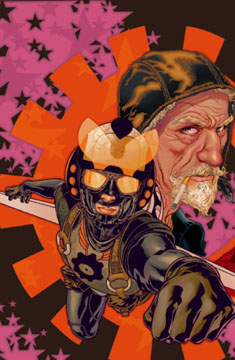 Bryan K. Vaughan probably has a lower commercial profile than any comparable talent working in comics today: Grant Morrison’s making bank with Superman, Frank Miller returns to Batman when he needs a boost, Warren Ellis has written the JLA and Ultimate Fantastic Four. But except for a brief run on Ultimate X-Men, Bryan K. Vaughan has contented himself to work on projects over which he has complete, or near-complete control, like Runaways and Y: The Last Man. Ex Machina is probably his most-honored book so far, and this two-part Special is the perfect place for new readers to get onboard.
Bryan K. Vaughan probably has a lower commercial profile than any comparable talent working in comics today: Grant Morrison’s making bank with Superman, Frank Miller returns to Batman when he needs a boost, Warren Ellis has written the JLA and Ultimate Fantastic Four. But except for a brief run on Ultimate X-Men, Bryan K. Vaughan has contented himself to work on projects over which he has complete, or near-complete control, like Runaways and Y: The Last Man. Ex Machina is probably his most-honored book so far, and this two-part Special is the perfect place for new readers to get onboard.
Ex Machina is the story of Mitchell Hundred, who in time-honored superhero fashion suffers an “accident” that gives him the power to control all types of machines with the sound of his voice. With his mentor, the crotchety Russian known as Kremlin, he sets off on a Rocketeer-like career as a well-meaning, if not wholly effectual, superhero, called The Great Machine.
All that changes on
This Special is the first complete tale devoted to Hundred’s superheroing career, beginning as the Mayor reflects back on those days during a radio interview. For all the books that have been done over the years on the subject of “What if superheroes were real?”, it’s startling how completely fresh Vaughan’s approach is—the first part of this story seems to show EXACTLY what it would be like if a person with extraordinary abilities took to the skies in a fancy costume: funny, scary, a bit weird, but also somehow a bit mundane.
We meet The Great Machine’s first super-powered adversary, and in vintage comics mode, his very existence is tied intimately to our hero. Their inevitable confrontation goes badly for Hundred, in a scene that is a model of suspense writing, as he works his powers on The Great Machine subtly, then explosively.
Ex Machina, the series, has benefited from what is probably the best artwork on any of
Ex Machina is one of those books whose reputation far exceeds its readership. When everyone from Wizard to Entertainment Weekly is telling you to read it, I can understand your being wary, but hey—now Thor’s warriors are telling you, and you know we don’t mess around. This is the perfect place to get onboard.
RATING: 
Impressive Anthology “Superior Showcase” Features Indie Superheroes
By Sean Fahey
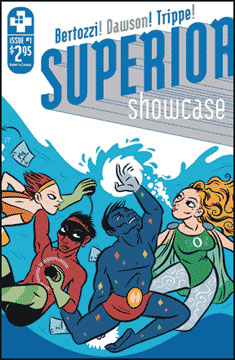 I’m not an expert on the indie comic scene. There are a lot of small press books that I love. There are a lot that I don’t, and there are even more that I don’t know about. But on principal alone, I dig the fact that there are a myriad of small publishers out there doing their own thing and telling diverse and compelling stories. Unfortunately, I think indie comics suffer from a negative perception that is (in part) fueled by a small sect of their fan base – and that is that indie comics somehow stand for the proposition that superhero comics “suck” and are nothing more than prepubescent male fantasy with nothing meaningful to offer. Well, you won’t be finding any of that nonsense in Superior Showcase # 1, a new anthology series that focuses on telling smart superhero stories with an indie vibe.
I’m not an expert on the indie comic scene. There are a lot of small press books that I love. There are a lot that I don’t, and there are even more that I don’t know about. But on principal alone, I dig the fact that there are a myriad of small publishers out there doing their own thing and telling diverse and compelling stories. Unfortunately, I think indie comics suffer from a negative perception that is (in part) fueled by a small sect of their fan base – and that is that indie comics somehow stand for the proposition that superhero comics “suck” and are nothing more than prepubescent male fantasy with nothing meaningful to offer. Well, you won’t be finding any of that nonsense in Superior Showcase # 1, a new anthology series that focuses on telling smart superhero stories with an indie vibe.
Superior Showcase is a spin-off from the critically acclaimed (and mammoth) Project Superior, and features three stories by some of the hottest indie talents around. Nick Bertozzi’s light-heated “Super Mart” is a day in the life of a superhero convenient store cashier. Homeless heroes cashing in change for bills (for booze next door). The annoying costumed store manager. Villainous thugs stealing frozen fish sticks. It’s a playful spin on the everyday. This is followed by Mike Dawsons’ powerful piece “Ace-Face: The Mod with the Metal Arms,” a story that pulls the rug out from under you, and casts the oft-heard “with great power comes great responsibility” mantra in a very different light. “Ace-Face” asks a lot of interesting questions (Is it more “important” to be hero or a celebrity? Does our society even want genuine heroes?), and is a thought-provoking work to say the least.
My favorite piece in Superior Showcase # 1 is Dean Trippe and John Campbell’s heartfelt and endearing vignette “Butterfly.” Unapologetically plucking inspiration from the Bat-Universe, “Butterfly” follows a disgruntled Birdie, feed up with the life and questioning whether it’s worth the effort. But Birdie finds inspiration in eager trick-or-treater who is enthusiastically jazzed about superheroes, and the two face-off against a trio of “hipster ghosts” (who materialize when something sincere is about to happen). The story reminds me in many ways of Mike Allred’s “Batman-a-go-go,” in the way that it embraces classic superhero traditions and values, and celebrates self-expression (even at the cost of not being “hip”). It’s very genuine.
This is a sharp book, and I’m looking forward to future installments. (To find out more about this book check out www.adhousebooks.com)
RATING: 
A Former Green Lantern Now Goes By the Name… Ion
By
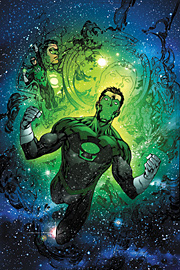 Contrary to popular belief, I actually do like Kyle Rayner. Well, maybe not as THE Green Lantern but…trust me, I do like him. Do I believe that he ever should have been on the same Justice League, much less, the same room as say…Batman? No. One thing about Kyle, though, just as sure as he could be counted on to say the wrong thing at the wrong time, one could just as easily count on him to, in times of crisis, always do the right thing. He wasn’t perfect but the kid had a good heart. You see, I actually think that’s the character’s appeal: Kyle is YOU as the superhero. Face facts, fanboy: no matter how much you’d like to believe, if you were dropped in The DC Universe and suddenly granted a Power Ring, more than likely your ass would not be JLA, more like Doom Patrol. That said, it’s a testimony to the character’s strength that with his never being the best man for the job and Harold Jordan be damned, it was Kyle who kept the Green Lantern concept strong for well over a decade. You’ve gotta respect him for that. Now, the new millennium finds him just as the cover of Ion #1 states: “Once a Green Lantern, now something more!”
Contrary to popular belief, I actually do like Kyle Rayner. Well, maybe not as THE Green Lantern but…trust me, I do like him. Do I believe that he ever should have been on the same Justice League, much less, the same room as say…Batman? No. One thing about Kyle, though, just as sure as he could be counted on to say the wrong thing at the wrong time, one could just as easily count on him to, in times of crisis, always do the right thing. He wasn’t perfect but the kid had a good heart. You see, I actually think that’s the character’s appeal: Kyle is YOU as the superhero. Face facts, fanboy: no matter how much you’d like to believe, if you were dropped in The DC Universe and suddenly granted a Power Ring, more than likely your ass would not be JLA, more like Doom Patrol. That said, it’s a testimony to the character’s strength that with his never being the best man for the job and Harold Jordan be damned, it was Kyle who kept the Green Lantern concept strong for well over a decade. You’ve gotta respect him for that. Now, the new millennium finds him just as the cover of Ion #1 states: “Once a Green Lantern, now something more!”
A world lies in ruin, its’ sun dead, its’ inhabitants dead and scattered about. In the middle of it all, a single young man, glowing green, muttering to no one in particular,“…I didn’t mean it…”
Elsewhere, in another place and time, Kyle Rayner is trying to find peace. It won’t come easily as a single, mace-wielding, winged figure swoops down from on high, with an intent to end his existence.
Writer Ron Marz (Witchblade) returns to the character that put him on the map. Marz certainly knows how to write a compelling mystery in space, wrapped up in a character study. Not many people know how to do that. Employing an easy, conversational style, Marz crafts a sweeping story that left me utterly perplexed. I mean this in a good way. One of the strengths of a good writer should be an ability to make the reader wonder and care about how a character came to be in the place they’re currently in. Ron Marz has done this thing. I’ll be back for the second issue.
Artist Greg Tocchini’s (Marvel 1602:
Ion #1 may simultaneously please/disgust/perplex long-time Kyle Rayner fans and you know what? In that, Ion #1 is a perfect metaphor for Kyle Rayner. I view that as a particularly good thing. Recommended.
RATING: 
Annihilation: Nova – a fun read, but he’s still a dork
By Graig
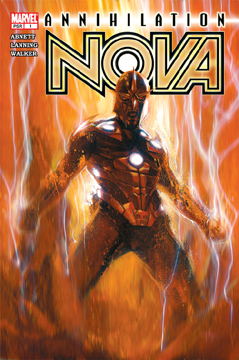 Let’s just admit it straight off… Nova is a dork. His costume is goofy, his powers are pretty generic, and he is/was a part of the New Warriors (enough said right there). On top of that, he’s a member of the Nova Corps – basically a second-rate Green Lantern Corps – which protects the galaxy, and the powers that be expect this doofus to protect Earth (actually, according to his bio in the back of the book, Richard Ryder was picked at random for the position… yeah, that’s always a good system for dispensing cosmic powers). Let’s just call Nova the Aquaman of the Marvel Universe (yes, I know Namor is the Aquaman of Marvel, but I’m just comparing on the “gas face scale” here).
Let’s just admit it straight off… Nova is a dork. His costume is goofy, his powers are pretty generic, and he is/was a part of the New Warriors (enough said right there). On top of that, he’s a member of the Nova Corps – basically a second-rate Green Lantern Corps – which protects the galaxy, and the powers that be expect this doofus to protect Earth (actually, according to his bio in the back of the book, Richard Ryder was picked at random for the position… yeah, that’s always a good system for dispensing cosmic powers). Let’s just call Nova the Aquaman of the Marvel Universe (yes, I know Namor is the Aquaman of Marvel, but I’m just comparing on the “gas face scale” here).
That said, you’ve got to give props to Dan Abnett and Andy Lanning for this issue… it’s centred on Richard Ryder in the aftermath of the destruction of Nova Corps’ homeworld Xandar, and it’s a lot of fun. Since Earth’s Nova is so conveniently the sole survivor of the entire Corps, he downloads Xandar’s Worldmind (the artificial intelligence cluster that is both the political and spiritual leader of the planet and its army… hmm, guess they don’t care much for separation of church and state) into his body. With the Worldmind now a part of him, Nova is exponentially more powerful… although Ryder is no more smarter than he was before and in this issue he attacks some of Annihilus’ straggling ships, making a very big boom, and causing a galaxies-away Annihilus to say “What…was that?”
Since Nova carries the only hope for the survival of the Xandarian race, his brashness needs tempering, thus the Worldmind starts to speak and guide him. Yeah, it’s been done before (see Firestorm, Deathlok, Hardware amongst others) but it’s a fun convention, and Abnett and Lanning put it to good use here. I like this writing duo, as they always seem to defy average storytelling. They’re able to amp things up just a notch or two above what most other creators do, without needing to go to extreme excesses. Here, as on titles like Majestic or their Legion run, they tell a conventional superhero stories but without the relying on a retro/nostalgia gimmic or without pushing things to “mature readers” level violence or content. It’s a fun sci-fi space faring adventure that capitalizes nicely upon Keith Giffen’s Annihilation Prologue.
The art by Kev Walker and Rick Magyar serves the story well, with dynamic “camera” positioning and dramatic figure movements. Their style is a sort of cross between Eric Larsen and early Mike Mignola, a heavy use of shadow, with gangly figure structures and sort of goofy-looking faces, but even when it’s not attractive it’s still pretty interesting. So far, Annihilation: Nova #1 is the best companion offshoot to the Prologue (plus, Drax shows up at the end, so I’m happy).
RATING: 
“Man-Bat” Returns with Horrific Consequence
By Mark Wheaton
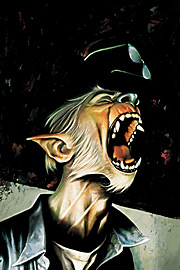 To say that “Man-Bat” is an odd, somewhat lesser Batman adversary is to make an understatement. A creature more akin to the Marvel world than DC, Dr. Kirk Langstrom – who Jekylls his hide into a monster bat that then attacks the innocent of Gotham – has been off the radar for a bit, living a quiet life with his wife and two kids, one of whom looks like Batboy the Musical. Normal as it’s going to get.
To say that “Man-Bat” is an odd, somewhat lesser Batman adversary is to make an understatement. A creature more akin to the Marvel world than DC, Dr. Kirk Langstrom – who Jekylls his hide into a monster bat that then attacks the innocent of Gotham – has been off the radar for a bit, living a quiet life with his wife and two kids, one of whom looks like Batboy the Musical. Normal as it’s going to get.
But then a spate of horrific, bat-type serial killing goes down complete with bodies drained of their blood and wham – a horror “Man-Bat” adventure begins…
…that also, somehow, involves Hush and Murmur (and, of course, Batman).
Writer Bruce Jones and artist Mike Huddleston quickly put comic readers on notice that this “Man-Bat” miniseries is going to be something different and, quite possibly, something special. Four pages in, you get the first decapitation. A handful of panels later and a man is torn out of his convertible, blood splattering back down on the hood. Then halfway through the book, the still-unseen Man-Bat slaughters two cops.
Are we 100% sure the man we glimpsed in the opening hidden in the cave with the bat was Langstrom? Yeah, getting there. Does the real Langstrom – who has no idea about the nocturnal habits of his alter-ego – garner our real sympathy when, by the end of the book, he finds his entire family slaughtered in the basement?
Yep. Every minor character in a comic universe can have its day, really, and this may be one of the best for Man-Bat. A grim, bloody, nasty piece of business that’s inclusion of the mysterious Hush could make this one for the ages. Like with all #1’s, here’s hoping.
RATING: 
Still Gross, Still Great: The Goon #17
By Jeb D.
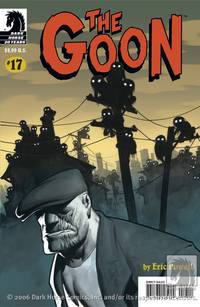 No one likes being typecast, and pop culture has a long history of pigeonholing creators based on early success. It would be very easy for writer-artist Eric Powell to fall into that trap, given the critical response to The Goon, and it’s interesting to see him start to make the first moves to avoid that.
No one likes being typecast, and pop culture has a long history of pigeonholing creators based on early success. It would be very easy for writer-artist Eric Powell to fall into that trap, given the critical response to The Goon, and it’s interesting to see him start to make the first moves to avoid that.
The Goon began a few years back with quick-hitting stories of slapstick horror, with every strange, silly, or grotesque thing Powell could think of spilling from his brain to the page in furious succession. It was riotous fun, sort of the bastard son of Ben Grimm and the Crypt-Keeper mashed up with the least sane stuff from Creepy and Mad. Now, in the wake of his Eisner awards, it looks like Powell wants to focus a bit more on the straightforward storytelling, with the book’s first really extended plotlines, designed to offer more than a rack to hang jokes on.
Of course, Powell’s hardly abandoned the jokes or the grossout—if anything, there’s stuff in issue #17 that’s more hilariously stomach-churning than usual. But more and more the series’ strength is in Powell’s sly imagination and gorgeous brushwork. I’m fairly certain that there is less dialog in this issue than in any Goon comic yet, but there’s panel after panel of artwork that will make you marvel and cringe at the same time.
We open with a delicious Hitchcock parody that becomes creepier than anything Hitch ever dreamed up, with the buildup of tension exploding as the Goon makes his first appearance in a stunning two-page spread. From there, it’s monster mayhem as The Goon, Frankie, and The Buzzard slug it out with an army of monstrous semi-human spider-babies, being cultivated by their old enemy the Zombie Priest. The action is furious, funny, and disgusting as always. And, yes, the letters page is still a riot.
Whether this extended-form approach is just a little experiment for Powell, or the plan to sustain The Goon for the long term, this book remains the most consistent guarantee of comics pleasure, month after month, on the stands today.
RATING: 
![]()

Superman Archives Volume 7
(DC Comics)
By Elgin Carver
 For young fans Superman probably seems an eternal, constant figure. Those who started reading comics in the 1950s know that not only has he changed, but when the Marvel revolution hit in the early 1960s, Superman seemed a tired, haggard, and shopworn commodity. Readers who began with the original superhero knew that the best, the most vivid and vital Superman came in the earliest years. When the concept of a person with extraordinary abilities was fresh, when the education level of the population was less, and hence their entertainment requirements needed a lesser level of complexity, a purity of realization was possible, that in a paradox of re-creation, we have returned to in many of today’s stories.
For young fans Superman probably seems an eternal, constant figure. Those who started reading comics in the 1950s know that not only has he changed, but when the Marvel revolution hit in the early 1960s, Superman seemed a tired, haggard, and shopworn commodity. Readers who began with the original superhero knew that the best, the most vivid and vital Superman came in the earliest years. When the concept of a person with extraordinary abilities was fresh, when the education level of the population was less, and hence their entertainment requirements needed a lesser level of complexity, a purity of realization was possible, that in a paradox of re-creation, we have returned to in many of today’s stories.
In these Archive editions we can again enjoy both a story-line and a drawing style that is simple and pure, where the comic artists could be likened to Giotto, learning and demonstrating the self taught lessons, of how to give two dimensional images weight and depth. The stories struggle to take an unadorned conflict of good versus evil, and draw out the depths of feeling that ordinary people experience in their daily battles to remain upright in the turbulence of life, much as Chaucer did with conversations on the way to Canterbury.
Are these comparisons overdrawn? Perhaps slightly. But here we have a new art form at its beginning, just as the "modern" history of western painting and literature began. It has taken some decades from these childlike beginnings to start to reach maturity. Today graphic novels are one of the prime sources for movie makers to mine for concepts, most full service bookstores have a selection for sophisticated readers, and public libraries now keep them on the shelves, an idea anathema during my childhood. True maturity of content must surely be just around the corner.
As no history of Western art could be properly taught or appreciated without beginning at least as far back as Giotto, and more likely all the way back to the Venus of Willendorf, a comic fan’s appreciation of their art form should go back to the earliest days of the earliest icons. Here are five consecutive issues of the foremost, and probably the most recognizable American symbol ever created, in his second level of creation. Jerry Seigel had been drafted (this was during the height of World War II), and those artists who had assisted Joe Shuster were now doing the majority of the artwork due to his poor eyesight, which had kept him out of the draft. Ed Dobrotka did a great deal of the interior work in these issues and Ira Yarbrough did most of the cover work.
The stories avoid the war for the most part and primarily deal with criminals part, in various locals, with common people, good and bad, although one story involves Superman traveling through time to slug it out with Greek gods, an uncomfortable forerunner to the Superman stories of the 1950s which kept me from the magazine for decades.
To this point, these Superman Archives are a refreshing and vital look into the past. Enjoy them while you can. The 1950s can’t be too far away.
RATING: 
Young Avengers vol. 1: Sidekicks
(Marvel Comics)
By Graig Kent
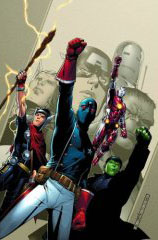 The good thing about the Young Avengers is right off the bat they’re an established part of Marvel continuity. Tossing the new, unknown teen heroes onto the front page of the Daily Bugle and then having Alias/The Pulse’s protagonist Jessica Jones, Daily Bugle Publisher J. Jonah Jameson, and another Bugle writer discuss the history of (the lack of) teen sidekicks in the Marvel Universe is a brilliant ploy to sidestep criticism about introducing, essentially, Teen Titans “Marvel style”. However, that still doesn’t make it any easier to accept Iron Lad, Asgardian, Hulkling and the Patriot as valid teen heroes.
The good thing about the Young Avengers is right off the bat they’re an established part of Marvel continuity. Tossing the new, unknown teen heroes onto the front page of the Daily Bugle and then having Alias/The Pulse’s protagonist Jessica Jones, Daily Bugle Publisher J. Jonah Jameson, and another Bugle writer discuss the history of (the lack of) teen sidekicks in the Marvel Universe is a brilliant ploy to sidestep criticism about introducing, essentially, Teen Titans “Marvel style”. However, that still doesn’t make it any easier to accept Iron Lad, Asgardian, Hulkling and the Patriot as valid teen heroes.
In the thick of “Avengers Disassembled”, the Young Avengers front page-worthy debut attracts the attention of Captain America and Iron Man, who seek out the teens to try and stop them from continuing to play the superhero game. Cap, they explain, still has issues over the “death” of Bucky decades ago, and will not see another teenager needlessly killed (“we’ll refer them to Xavier’s school” Iron Man states, because, yeah, their track record at not killing teens is sooo good). But without the Avengers around, who’s supposed to stop Kang the Conqueror from taking over present-day earth? Somehow these teens know what’s going to happen, and they’re the only ones that can stop it, with the help of Ant-Man’s daughter and a bored socialite teen princess (who dons some of Hawkeye’s gear).
The major plot involves some fairly straightforward time travel elements, which new-to-comics writer (well, he was new when he wrote the issues compiled here) Allan “I created the O.C.” Heinberg pulls off well, and generally he succeeds in introducing these teens as adeptly as Marv Wolfman did back in the 80’s with the New Teen Titans. Unfortunately, a lot of the subtext, such as should kids be superheroing, has been done better, many times, and even the Captain America stopping the kids subplot was done recently in Runaways. Actually much of the Young Avengers: Sidekicks seems to be treading similar but less-interesting ground as Runaways, even team dynamics. And the title is misleading, because these kids aren’t actually sidekicks.
The art by Jim Cheung is good, using a nice, thin, open line for rendering which I always like, without going overboard in crosshatching and business. He doesn’t have a lot of breadth in his facial repertoire, so most of the characters are distinguishable only by hair or costume, and, like a teen horror movie, there’s not much emoting emanating from the face. Overall, Young Avengers is decent but not spectacular.
RATING: 
BLADE OF THE IMMORTAL VOL. 15: TRICKSTER
(Dark Horse)
By Chris B.
 In Blade of the Immortal Hiroaki Samura has avoided most of the things that (to risk generalizing) are least appealing about popular manga. Self-important stargazing philosophy, watery puppy dog eyes, and generic characterization are largely absent from his work, and he tells his stories with as much energy and force as any creator alive. The plot of Blade is no great shakes: a surly, near-unkillable swordsman helps a young girl to get revenge on the men who murdered her parents. The strength of the series is in the way it has expanded upon its premise and its world, building up its solid ensemble of characters and playing them off against each other. Samura has gradually shifted the character of the art as well, abandoning the cleaner, more familiar style of the first issues, collapsing it down to sketchy, furious motion and angles, where every texture is a maze of cross-hatching, and every character’s face is lined in such a way that they never seem to stop moving.
In Blade of the Immortal Hiroaki Samura has avoided most of the things that (to risk generalizing) are least appealing about popular manga. Self-important stargazing philosophy, watery puppy dog eyes, and generic characterization are largely absent from his work, and he tells his stories with as much energy and force as any creator alive. The plot of Blade is no great shakes: a surly, near-unkillable swordsman helps a young girl to get revenge on the men who murdered her parents. The strength of the series is in the way it has expanded upon its premise and its world, building up its solid ensemble of characters and playing them off against each other. Samura has gradually shifted the character of the art as well, abandoning the cleaner, more familiar style of the first issues, collapsing it down to sketchy, furious motion and angles, where every texture is a maze of cross-hatching, and every character’s face is lined in such a way that they never seem to stop moving.
Lately, though, the series has been in sort of a lull. Samura split his characters up and kept them on the road for a number of volumes leading up to “Last Blood,” the story’s effective peak so far, when he brought them all back together. The book’s central interrogation of revenge, and its examination of every member of its huge cast – as well as the process of attrition natural to a story about people with swords killin’ stuff – seemed to bring it to a point where it had almost no villains left. Add to this Samura’s recent unwillingness to kill off any of his major characters, and you get a relatively undistinguished story like “Trickster,” where a couple of new characters are introduced and promptly killed, loose ends are tied, and the set-up continues for a showdown between the protagonists and the government.
While the one-off character pieces in the latter half of this volume are excellent, “Trickster” for the most part feels like Blade of the Immortal treading water. Samura can draw great action scenes and he knows it; he can introduce new villains and make them immediately interesting (there’s a great story about a bear buried somewhere in here). His comic will still be worth reading if he keeps doing these things. But characterization is his strong suit, and his talent for it is under-represented here.
RATING: 
![]()

 Fury: Peacemaker #3 (Marvel) – When Garth Ennis and Darick Robertson teamed for the cool, post-Cold War “Fury” a couple of years back, it was sadistic, darkly comic and grotesque – the perfect prism to look at some of these old cold warriors through, many of which are still in power (particularly in this country). “Fury: Peacemaker,” however, was much more above-the-boards – inserting a young Sgt. Fury into one of the Ennis “War Stories” a
Fury: Peacemaker #3 (Marvel) – When Garth Ennis and Darick Robertson teamed for the cool, post-Cold War “Fury” a couple of years back, it was sadistic, darkly comic and grotesque – the perfect prism to look at some of these old cold warriors through, many of which are still in power (particularly in this country). “Fury: Peacemaker,” however, was much more above-the-boards – inserting a young Sgt. Fury into one of the Ennis “War Stories” a